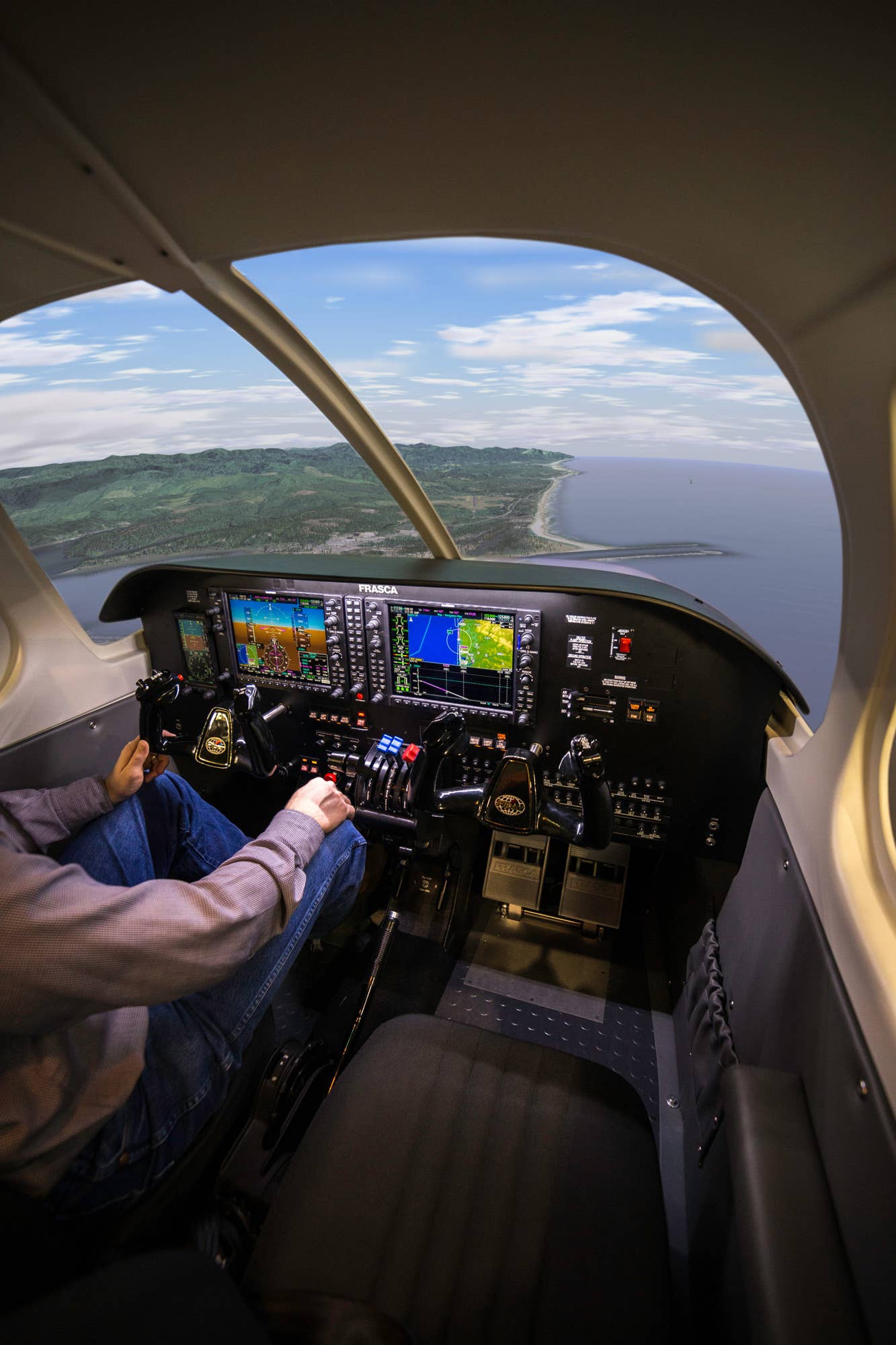Simulation Technology, Not Just for Airlines
Save time and money—and maybe your life—with some simulator experience.

[Courtesy: Frasca International]
"Aviation in itself is not dangerous. But to an even greater degree than the sea, it is terribly unforgiving of any carelessness, incapacity, or neglect." —Alfred Gilmer Lamplugh
While many pilots wouldn’t know who came up with Lamplugh's famous quote, most pilots would agree with it. There is risk in just about every facet of life, but in aviation the inability to manage that risk—because of overconfidence, a lack of preparation, or rusty skills—can be deadly.
One way to mitigate these risks is to practice aviation procedures and run through potential flight scenarios in a controlled environment using a flight training device (FTD)—colloquially referred to as a simulator.
If you're not already a subscriber, what are you waiting for? Subscribe today to get the issue as soon as it is released in either Print or Digital formats.
Subscribe NowUnlike the aircraft, an FTD or its less complex sibling, the advanced aviation training device (AATD), can be paused mid-flight, allowing you to recognize a mistake or poor decision and take prompt and corrective action. This builds good habits that, hopefully, are carried into the aircraft.
Link Trainer, the First FTD
In 1929, Edwin Link of New York introduced the Link Trainer. From the outside, the Link Trainer’s short wings and tail looked like a carnival ride or a cartoon airplane brought to life. It was built with vacuum-tube technology, valves, bellows, belts, and pulleys, which was state-of-the-art technology at the time. The enclosed cockpit sat several feet off the floor. The instrument panel was outfitted with an RMI, VOR, radiocompass, and attitude indicator along with engine instruments. The Link could physically pitch, yaw, and roll. An instructor sat at a console outside the device where they could control the parameters of the flight.When activated,
the device would start to rotate, disturbing the pilot’s vestibular sense, forcing the pilot to “get on the instruments” to keep the “aircraft” upright and on course as the instructor adjusted flight conditions from the outside.
Inside the box, the pilot sweated in more ways than one, since the device had very little ventilation.
Link’s first customer was the U.S. Army, which had been losing pilots to weather-related accidents at an alarming rate. Sales would increase dramatically during World War II, as Link Trainers were used to train some 500,000 U.S. pilots. Each unit cost approximately $3,500 in 1941. Today, that’s more than $70,500.
The company still continues to build training devices for the transportation industry, and today is known as the Link Simulation and Training division of L3 Harris Technologies.
Frasca: FTDs for GA
In 1958, former Navy flight instructor Rudy Frasca (now deceased) started his own company building flight training devices. The company, today known as Frasca International and owned by FlightSafety International, makes everything from FTDs representing light training aircraft, such as the Cessna 172, Diamond DA40, and Piper singles and twins, all the way up to jets and turboprops used by airlines and corporate flight departments—in order to train their flight crews.
The Urbana, Illinois-based company is now led by president John Frasca, Rudy’s son. The younger Frasca joined the business in 1972, sweeping floors and working his way up with a front-row seat to the changes in simulation technology.
“The first devices Dad built were based on mechanical linkages and levers and solenoids, then they evolved to analog electronics with resistors with soldering irons and transistors,” Frasca says. “Then it evolved into micro-process computers,” he says, noting that the evolutionary mission is still key at Frasca.
“We are absolutely an engineering company,” Frasca explains. “Engineers evolve the technology to stay on the cutting edge, but we have to be careful to keep designs reliable and effective and economical. It would be possible to make a Level D full-flight sim for the Cessna 172, but it would be so expensive it is unlikely that anyone could afford it.”
The FAA approves flight training devices as either basic aviation training devices or AATDs. Many schools opt for the AATD as they offer learners the opportunity to gain more hours of loggable experience.
Frasca AATDs at most flight schools range from a semi-enclosed cockpit, where the pilot looks at an instrument panel, to a design expanded to include computer screens to give the pilot a more immersive experience.
“They started as instrument procedure trainers, then schools came to us and asked for devices that had control loading, like their Cessna 172 and Piper Archer, then they asked for special avionics, like [the Garmin] G1000,” Frasca says.
Realizing that flight schools often have more than one model in their hangar, Frasca developed the Reconfigurable Training Device AATD that allows the unit to be quickly configured to represent multiple aircraft, such as the Cessna 172, and Piper Seminole and Archer.
What’s the most important thing to remember when using a training device, according to Frasca?
“Treat it like an airplane,” he says, noting that they can build a device that looks, behaves, and—for the most part—handles like the airplane it represents.
“These FTDs have FAA approval and we use them to teach air work, emergency procedures and in some cases, takeoffs and landings.
“With a good instructor and a strong curriculum, they can learn good habits,” he says. As technology continues to evolve, there are improvements in fidelity that could potentially see the use of artificial intelligence to provide instruction, he adds.
“We’re looking at tools to make the instructor’s job easier, such as the use of CloudAhoy,” Frasca says.
The CloudAhoy app records the metrics of the flight and allows a playback later for an in depth debriefing, working in concert with the Frasca devices.
NASA Experiment, Simulation Required
In the 1990s, NASA sought to revitalize the dwindling aviation industry, and made simulation technology part of the process when it created the Advanced General Aviation Training Experience (AGATE) program. The concept shared by government, industry, and academia was to enhance training for pilots and improve aviation technology, which had largely remained untouched for several decades.
California-based Precision Flight Controls was founded in response to the AGATE program, and was one of the first companies to produce desktop and full size training devices for airplane pilot proficiency. It was also one of the first companies to gain FAA approval for them.
The simulators run the gamut from single-engine trainers, such as Cessna, Piper, Diamond, and Mooney designs, to multiengine aircraft, helicopters, turbo-props, and jets.
According to Precision Flight Controls CEO Mike Altman, the company’s mission lies in the creation of cost-effective training devices that are “performance accurate.” That takes robust computers with backups upon backups.
“We run on six image generators. If you load up a PC, it gets more pixelated and operates slower,” he says. “We want at least 60 frames of horsepower, fast video cards with backup drivers, and solid-state drivers.”
When a computer powering the simulation slows down, according to Altman, it ruins the efficacy of the experience for the user. That’s why it’s important that the simulator performs as close as possible to the actual aircraft. The customers are encouraged to test-fly the devices to check for performance and feel for accuracy.
“We want to make sure the customers are happy with it and they get pretty close on feeling and fine-tuning of the motions and control locations compared to the performance of the model,” he says. “The last thing you want is negative transfer between sim and airplane.”
The software makes it possible for the flight instructor to change the parameters of the flight with a single keystroke. That means weather or the performance of the aircraft is just one touch away from becoming challenging.
Scenario-Based Training
Used by the military and at the airline level for decades, scenario-based training (SBT) gained a foothold in the GA world in the 2000s. One of the first simulation companies to embrace SBT was Texas-based Redbird Flight Simulations, founded in 2006. The company makes several devices ranging from desktop models to the FMX, a full-motion device.
Redbird was one of the first simulation companies to embrace preloaded scenarios on its devices, according to Todd Willinger, one of the company’s founders and its CEO.
“The devices came with a dozen preset scenarios that were applicable to the private pilot or the instrument pilot,” Willinger says. “They often had the pilot flying out of Austin or San Marcos [Texas] with various weather conditions. We had one with the pilot flying out of Aspen, Colorado (field elevation 8,440 feet), on a hot day.”
This scenario-based training was quickly embraced by the Society of Aviation and Flight Educators, and later, the National Association of Flight Instructors, which developed the Pilot Proficiency Center (PPC) at Wittman Field (OSH), in Oshkosh, Wisconsin. During EAA AirVenture each summer, the PPC uses volunteer CFIs in Redbird FTDs and a crosswind trainer to put pilots through their paces. Last spring, the PPC was given a permanent home at Wittman Field in a newly constructed facility attached to the EAA Museum.
The scenarios for the PPC are created by Billy Winburn, president of Community Aviation and Mindstar Aviation, a company that specializes in flight simulation software. According to Winburn, the most challenging part of scenario creation is the fine-tuning of the scenarios.
“Many of the simulation missions are highly customized with high-resolution scenery and script commands that drive special effects for weather, aircraft handling, traffic, etc.,” Winburn says. “These enhancements are typically way outside of normal flight simulation software capabilities. Some of this is done internally but a lot of the add-ons are generated from third-party contractors, like Mindstar Aviation, who specializes in flight simulation software. To get the weather effects just right, you often have to interpolate the flight sim settings for the exact locations and behavior of clouds, visibility levels, winds aloft, etc. We also use special control scripts that can manipulate the flight files and drive weather directly.”
Each mission scenario comes with a lesson plan to be utilized by the pilot or the CFI.
“The scenarios [for] PPC use Redbird AATDs exclusively,” Winburn says. “These sims use an instructor station called Navigator that allow the flight, weather, and control script files we generate to work with any aircraft type that Redbird supports.”
New missions are added each year, and others are tweaked and retired, depending on feedback from the participants. This past year, the PPC had 10 missions that were developed in concert with the educators leading various clinic knowledge sessions, such as the Recreational Aviation Foundation for BackcountryAwareness scenarios.
According to Willinger, “flying” a scenario not only provides the pilot with a chance to gain proficiency, it can also help them build confidence as they have rehearsed the flight in the sim before attempting it in the real world.
Necessity Breeds Invention, Opportunity
One of the common complaints about the use of simulation technology is that often the hours spent in the device do not “count” toward the time required for a certificate or rating.
This attitude is in error, suggests Xylon Saltzman, founder and CEO of One-G simulations based in Seattle, Washington. In 2010, Saltzman was flying corporate charters in a Cessna 340 and had to travel to Scottsdale, Arizona, for recurrent training in the only FAA model-specific sim in the country.
“The trip was truly painful and it became obvious that there needed to be better access to equipment,” he says.
Saltzman, who has an engineering background, started building a simulator in his garage with the idea that the device could “provide beneficial instruction for all levels of pilots, starting from those with no experience.”
By 2011, the company—known as One-G—had its first design and first letter of authorization from the FAA. “We formed the company around that,” Saltzman says.
The training model was developed by a sister company, Modern Pilot, which also serves as a beta test facility for One-G designs. Learners have the option off lying the Foundation sim, which is a Cessna 172 with either G1000 or round dial, a Beechcraft Bonanza, or a Pilatus PC-12.
“Time in the AATD gives the learner familiarity with the cockpit but removes the fear and anxiety that often comes with flight training,” Saltzman says. “There is a direct correlation between what they see in the AATD and the flight deck of the airplane.”
AATDs are also much less expensive to purchase and operate than airplanes, Saltzman notes, adding that simulation experience—when properly applied—can expedite a private pilot’s learning process because the simulator can be paused, creating a better teaching environment. Also, as technology improves, so does the fidelity of the devices, allowing the learner to get more out of the experience, he says.
“Good habits can be learned there,” he says. “It doesn’t have to be FAA-approved time in order for it to be useful, but we’ve seen the FAA change its view on how valuable simulation instruction is—because in 2016, the FAA updated the FARs to state that 20 of the 40 hours required for the instrument certification could be acquired in an AATD.”
In fact, those hours can hold value regardless of whether they’re logged as flight time, given the effectiveness of training in the sim world and how it translates into pilot performance.
This article was originally published in the December 2022/January 2023 Issue 933 of FLYING.

Sign-up for newsletters & special offers!
Get the latest FLYING stories & special offers delivered directly to your inbox







